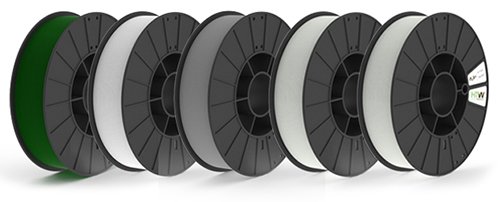Materials used in 3D printing - best 3D printer fiaments
3D printing filaments are presented in a wide range. We tried to describe briefly the most popular and widely used best 3D printing materials for nowdays. And the popular question "What materials can be 3D printed?" actually should be changed to "From which materials it is possible to use printed objects in different cases?". Improperly choosed filament (3D printing plastic) could play a low-down trick. As an example, if pour wine (or other alcoholic drink) to a glass made from ABS plastic, as a result of a chemical reaction styrole (mutagene and cancerogene) will be evolved. Or if a flower will be planted to a flowerpot made from PLA filament, you finally will be surprised when will find it not in a the pot on a window sill, but directly on an expensive carpet. So it is important to pay attention to the properties of choosed materials and check if it is suitable for printing the object.
ABS filament
ABS plastic is a very common 3D printing material, which is widely used in plastic objects in our everyday routine (frames, cases, gear-wheels, fastening elements). The extrusion temperature of ABS filament 210–245°С. Goods made from this plastic could be used up to 90°C, are strong and at the same time this filament (and goods) is flexible enough. This printing material is easy for postprocessing, details from ABS plastic could be easily coloured and glued, it is soluble in acetone.
PLA+ filament
PLA plastic is a polyester, safe 3D printing material, which consists of polylactic acid and is manufactured from plant materials (corn, sugarcane, beets). PLA+ plastic has a range of special additives, which make it less fragile and breakable. This additives allow to approximate the properies of PLA plastic filament to properties of ABS filaments. Postprocessing of goods from PLA filament is more difficult in comparison with ABS plastic, details are hardly to stick together, poorly soluble in acetone. Plastic PLA temperature of printing (extrusion temperature) is 180-230°C. During the 3D printing process and melting of the plastic toxic substances are not evolved. It is characterized by low shrink factor and safe for humans. For the same reasons it is suitable for manufacturing of plastic housewares and goods for medical purpose.
Due to the low shrinkage factor, the usage of PLA+ filament in 3D printing is very easy. The goods from this PLA plastic are readily biodegradable and can be used in the food and in medical fields.
FLEX filament
FLEX is a flexible filament, which properties are similar to solid silicone. The melting temperature of this filament is 205–245°C. This printing material is oils and solvents resistant. It is difficult for mechanical processing, characterized by high-wearing feature. Details, printed from FLEX fiament can be sticked together with synthetic gum or with using of soldering fan.
RUBBER filament
The properties of this 3D printing filament is very close to the resin elastic, it repeats all its capabilities. RUBBER filament extrusion temperature starts from 200–240°C. Detais from the RUBBER material can be glued with synthetic gum or with using of soldering fan, are oil and benzine resistant. This well suits for printing of buttons, draught seals, buffers, amortisseurs.
CRYSTAL filament
This clear 3D printer filament is characterized by high translucent capability. The extrusion temperature of CRYSTAL plastic is 200–245°C. As a PLA filament, this material is very safe and has alike capabilities, but it differs by higher flexibility and springiness. The frinkage factor of CRYSTAL filament is higher than PLA.
This plastic is suitable for medical and food fields, for manufacturing of children's toys.
